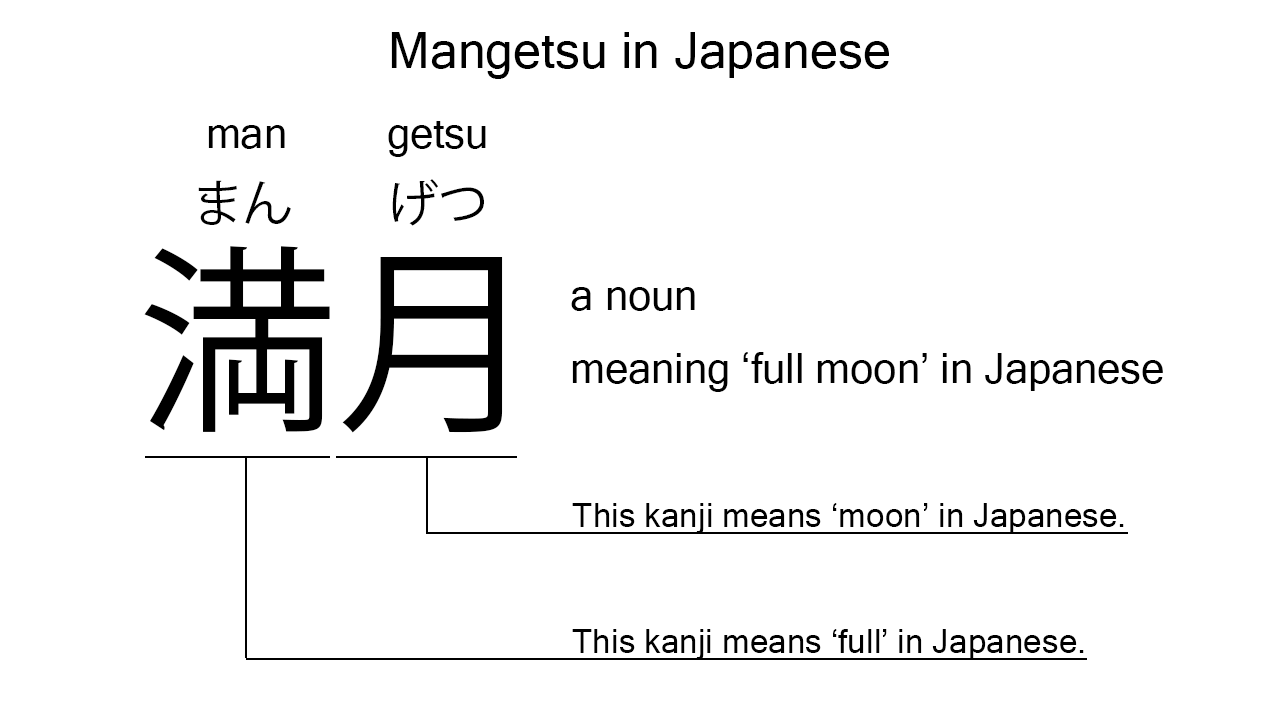What does “mangetsu” mean in Japanese?
Native speakers use mangetsu to mean the ‘full moon’ in Japanese. Perhaps, some Japanese learners know this word as it is sometimes used in Japanese movies, songs, novels, manga, anime, and the like. In this blog post, however, I’m explaining this word in detail based on its kanji expression. And also, I’m explaining how to use it through example sentences. My explanations would help Japanese learners understand mangetsu more clearly. Then, let’s get started!
Contents
Definition and meaning of “mangetsu”
Let me start with the definition and meaning of mangetsu.
- mangetsu – 満月 (まんげつ) : a noun meaning the ‘full moon’ in Japanese.
The definition and meaning are simple and clear. To understand this noun more clearly, however, let me explain its kanji characters in detail, one by one.
Japanese kanji for ‘full moon’
The Japanese kanji expression for ‘full moon’ consists of the following two kanji characters:
- 満 : a kanji character sometimes used like a prefix to add the meaning of ‘full’ in Japanese.
- 月 : a kanji character used to mean ‘the moon’ or ‘month’ in Japanese.
From these two kanji characters, we can understand that mangetsu literally means the ‘full moon’ in Japanese. This literal interpretation is completely in line with the actual meaning.

When we meet new kanji expressions, we should check their kanji characters in detail to understand their meanings clearly and deeply. In many cases, kanji characters tell us a lot about the meanings of the expressions they form. Actually, here, we could get the better understanding of mangetsu through the detailed kanji check above.
So far, I’ve explained the definition and meaning of mangetsu together with its kanji characters. Then, let me explain how to use it through the example sentences below.
How to say “full moon” in Japanese
kyou wa mangetsu desu – 今日は満月です (きょうはまんげつです)
There is the full moon today.
Below are the new words used in the example sentence.
- kyou – 今日 (きょう) : a noun meaning ‘today’ in Japanese. This can also work as an adverb almost anywhere in a sentence.
- wa – は : a binding particle working as a case marker or topic marker. In the example, this works as a topic marker after kyou to put a focus on it.
- desu – です : an auxiliary verb used after a noun or adjective to make it polite. Probably, this is well known as a part of Japanese desu form. In the example, this is used after mangetsu to make it sound polite.
This is a typical usage of mangetsu. Japanese native speakers often use this example sentence on the nights of the full moon. It’s worth knowing, I think.
Another example of “mangetsu”
「mangetsu ga akaruku te kirei」 to kanojo ga it ta – 「満月が明るくて綺麗」と彼女が言った (「まんげつがあかるくてきれい」とかのじょがいった)
“The full moon is bright and beautiful,” she said.
Below are the new words used in the example sentence.
- ga – が : a case particle used to make the subject word or the object word in a sentence. The first ga in the example is used after mangetsu to make the subject in the clause.
- akaruku – 明るく (あかるく) : one conjugation of the i-adjective, akarui, which means ‘bright’ or such in Japanese. In the example, it has been conjugated for the better connection with its following word.
- te – て : a conjunctive particle used after a verb, adjective, or auxiliary verb to make its te form. In the example, this is used after akaruku to make its te form, akaruku te. This te form can have a smooth connection with the following adjective.
- kirei – 綺麗 (きれい) : the stem part of the na-adjective, kireina, which means ‘beautiful’ in Japanese. This can work like one conjugation of kireina and mean ‘beautiful’ in Japanese.
- to – と : a case particle working as a quote marker. In the example, this works after the clause to indicate what she said.
- kanojo – 彼女 (かのじょ) : a pronoun meaning ‘she’ in Japanese.
- it – 言っ (いっ) : one conjugation of the verb, iu, which means ‘to say’ in Japanese. In the example, it has been conjugated for the better connection with its following word.
- ta – た : an auxiliary verb used after a verb, adjective, or auxiliary verb to make its past tense form. In the example, this is used after it to make its past tense form, it ta.
This is another example of mangetsu. When we want to mean the ‘full moon’ in Japanese, this noun is always a very good option.
Summary
In this blog post, I’ve explained the definition and meaning of mangetsu in detail based on its kanji expression. And also, I’ve explained how to use it through the example sentences. Let me summarize them as follows.
- mangetsu – 満月 (まんげつ) : a noun meaning the ‘full moon’ in Japanese. These two kanji characters literally mean the ‘full moon’ in Japanese. This literal interpretation is completely in line with the actual meaning. When we want to mean the ‘full moon’ in Japanese, this noun is always a very good option.
Hope my explanations are understandable and helpful for Japanese learners.
Leave a Reply